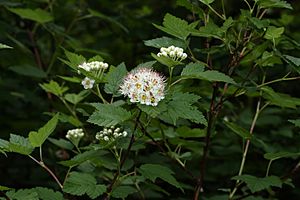Pacific ninebark facts for kids
Quick facts for kids Pacific ninebark |
|
|---|---|
 |
|
| Scientific classification | |
| Genus: |
Physocarpus
|
| Species: |
capitatus
|
The Pacific ninebark (scientific name: Physocarpus capitatus) is a cool plant that grows in western North America. You can find it from southern Alaska all the way down to southern California, and even east to Montana and Utah. It's also known as tall ninebark.
Contents
What is Pacific Ninebark?
The Pacific ninebark is a type of shrub. This means it's a woody plant that is smaller than a tree. It can grow to be about 1 to 2.5 meters (3 to 8 feet) tall. It is a deciduous shrub, which means its leaves fall off in the autumn.
How Pacific Ninebark Looks
The name "ninebark" comes from its unique bark. The bark is flaky and peels away in many layers, almost like old paper. This gives the plant a very interesting look.
Leaves and Flowers
The leaves of the Pacific ninebark look a bit like maple leaves. They have several lobes (sections) and can be from 3 to 14 centimeters (1 to 5.5 inches) long and wide.
In spring, the plant grows clusters of small white flowers. Each flower has five petals and many stamens. The stamens are the parts that hold pollen, and they often have red tips, making the flowers look even prettier.
Fruit and Seeds
After the flowers bloom, the plant produces unique fruit. These fruits start as inflated, glossy red pods. As they get older, they turn dry and brown. Then, they split open to release their tiny seeds. This is how the plant reproduces and makes new ninebark plants.
Where Pacific Ninebark Grows
Pacific ninebark loves wet places. You can often find it in wetlands, which are areas where the land is covered by water, like swamps or marshes. It also grows in thick groups along rivers and in moist forest areas.
Even though it grows best in wet places, it can also handle some dry weather. This makes it a popular plant for gardens, especially in California. It's a tough plant that can adapt to different conditions.


